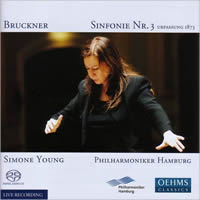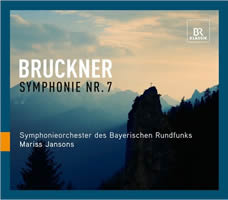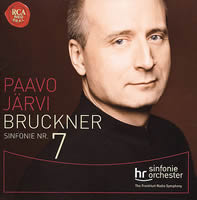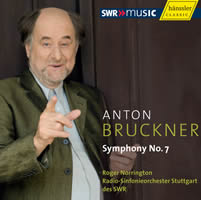Threes and Sevens
|
Dan Albertson [December 2010.] [A new series. How many have I begun and never finished? Someone rescue me from this Boulez syndrome, please. Will you be the one, Anton? Thank you, Tom Service, for your good memory, and Glen Kabumoto, for what we forgot — and keep forgetting. Te agradezco, Mayuko Arai, a porteña of a sort when I least expected one. That I thank Sid Samberg, for his tolerance of my gentile ways, is automatic. D.A.] Is Brucknerophilia a recognized medical condition? I caught it early in life and find that it grows worse, by which I mean better, with age. Recordings of his symphonies are now voluminous enough to make comparisons thereof a full-time pursuit. If only the rewards were richer. For now, two threes and four sevens will suffice.
Anton BRUCKNER: Symphony No. 3 in D minor (1873, rev. 1874, 1876, 1877, 1888-89). 1873 version. Philharmoniker Hamburg, Simone Young (cond.). OehmsClassics OC 624 (http://www.oehmsclassics.de/). Distributed in the US by Naxos (http://www.naxos.com/). This recording, assembled from three live performances in Hamburg in 10/2006, shows the merits of the original version of this “Wagnerian” symphony, with a particularly fine acoustic and sympathetic playing. Here is a work of considerable difficulty, done with aplomb. The notes reveal it to be the longest Bruckner symphony, bar-by-bar. The scherzo will always seem to have strange rhythms for anyone adjusted to the revised version. Applause has been omitted, though rustling between movements has been preserved. Why the halfway approach, I have no idea.
Anton BRUCKNER: Symphony No. 3 in D minor (1873, rev. 1874, 1876, 1877, 1888-89). 1888-89 version. Mozarteum Orchester Salzburg, Ivor Bolton (cond.). OehmsClassics OC 722 (http://www.oehmsclassics.de/). Distributed in the US by Naxos (http://www.naxos.com/). A disappointment. I rather admire Bolton, but the brass, in particular, are not as clear as I require. The lovely strings almost compensate. No distinctive characteristic otherwise. The recording dates from 10/2007, made from two live performances in Salzburg, again with no applause and now no rustling either. Verdict: skip, regrettably. Bruckner: Symphony No. 3
Anton BRUCKNER: Symphony No. 7 in E major (1881-83, rev. 1885). Symphonieorchester des Bayerischen Rundfunks, Mariss Jansons (cond.). BR-KLASSIK 403571900100 (http://www.br-online.de/). Distributed in the US by Naxos (http://www.naxos.com/). Seldom has such a fine piece left me so bored. I remain in disbelief that such inspired, and in its turn inspiring, music could be performed in such a lifeless, stolid fashion. The applause from Vienna in 11/2007 is intact and rapturous: Go figure. The first movement earns no sympathy from me, with weak climaxes, tepid winds and turbid strings. The Adagio has the notorious cymbal crash, subject of endless debate, and a dreary pace. The scherzo plods along. The finale has no dramatic sense. Snooze.
Anton BRUCKNER: Symphony No. 7 in E major (1881-83, rev. 1885). Mozarteum Orchester Salzburg, Ivor Bolton (cond.). OehmsClassics OC 568 (http://www.oehmsclassics.de/). Distributed in the US by Naxos (http://www.naxos.com/). Another snooze, damn, and from such an unexpected source. Look at how close Bolton is in tempo to Jansons; what is happening here? He even uses a cymbal crash himself! Here is another live performance from Salzburg, 2/2006. At least the strings have some definition.
Anton BRUCKNER: Symphony No. 7 in E major (1881-83, rev. 1885). hr-Sinfonieorchester, Paavo Järvi (cond.). RCA Red Seal 88697389972 (http://klassik.sonymusic.de/). A third cymbal crash. Another finale utterly ineffectual in design and effect, with yet another middling scherzo and still more orchestral groups with no personality. A composite live recording, here three concerts in 11/2006. The applause was removed, but was likely enthusiastic. More proof that mediocrity passes for brilliance these days.
Anton BRUCKNER: Symphony No. 7 in E major (1881-83, rev. 1885). Radio-Sinfonieorchester Stuttgart des SWR, Sir Roger Norrington (cond.). hänsslerCLASSIC 93.243 (http://www.haenssler-classic.de/). Distributed in the US by Allegro Music (http://www.allegro-music.com/). Regular readers will know of my fondness for Norrington. I assure them that the fix is not in: Listen to these recordings for yourself, as I have listened to them, and try to persuade yourself that Norrington is the countless adjectives that critics throw at him — cold, cool, harried, lifeless, etc. I hear a fleet, consummate performance, in which the orchestral balances and the contours of the score are understood intimately. No cymbal crash interferes with the Adagio and the codas to the opener and finale are thrilling, not only by themselves, but also by the careful manner in which they are gradually allowed to build. Quibbles exist, with regard to certain emphases, but therein lies the joy of interpretation. The best part is that the applause is included — and it is so hesitant as to seem that the piece were unknown by those in attendance. Amusing! Bruckner: Symphony No. 7 (1881-83, rev. 1885)
[Bruckner’s symphonies boast an informative website. W.M.]
[More Dan Albertson]
[More
Bruckner]
[Previous Article:
Awrite, Erik Chisholm!]
[Next Article:
Rocket Science]
|





